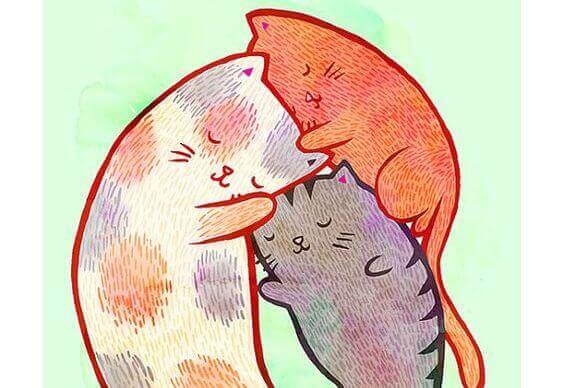How Courtesy Affects Your Relationships


Written and verified by psychologist Valeria Sabater
Courtesy has many benefits. Not only does it resonate with others, but it also does us good. On an emotional level, it helps us to be in harmony with those around us.
Above all, courtesy is a personal value. From the time we are children, others teach us the basics of courtesy and living together.
For these teachings to be effective and useful, it is important for us to be mindful of these rules. Because courtesy and other values are only good when we use them, keeping them in our minds is the only way to apply them. On the other hand, you could always get a cute print to place on the wall: that way you’ll never forget about it!
Being courteous requires will.
Courtesy is synonymous with likability and recognition towards someone else. It is a universal form of respect. When we’re courteous, we are able to enjoy the best relationships with others.
Nevertheless, it’s common to forget some of these values, and our relationships can suffer because of it.
Courtesy, a way to give off positive energy
Something we have all noticed is the power of small gestures from day to day. From “how are you?“ to “thank you” and “take care”, small actions and words connect us to one another.
Also, keep in mind that none of this is possible if you aren’t intentional. To give respect, you need to be close and have a clear goal. You also need to know what needs others have.
We invite you to reflect on this topic by looking at some concrete ideas.

Why are there people that lack courtesy?
Being courteous is more than the good manners we learn as children. It goes beyond holding the door, giving thanks, giving your seat to someone, or even listening before you speak…
We could say that this dimension is not practised by everyone. Above all, it’s a very individual value.
-
Those who aren’t courteous don’t empathize with others. It’s common for them to put themselves first. They have a proud or defiant attitude.
-
Courtesy is a strategy that allows us to adapt to our environment. Those who lack manners hope that others will change for them.
Dr Pier Massimo Forni is a doctor and professor at John Hopkins University. Out of all of his social behaviour work, his book “Choosing Civility: The 25 Rules of Considerate Conduct” stands out.
In his book, Dr Forni states that a lack of courtesy can be the defining factor in distinct types of social aggression. Also, some cases may stem from emotional maturity or psychological problems.
Maybe you’d like: Microaggressions in a Relationship: A Couple’s Worst Enemy
Kinds of courtesy
An interesting observation is that there are different kinds of courtesy. Stephen Levinson is a scientist who specializes in social relationships. He distinguished two kinds of courtesy that we can see.
-
Negative courtesy: This is related to the language we use. It primarily uses negative sentence structures. Some examples include: “if you don’t mind…” or “if it doesn’t bother you, I’m going to…”
-
Positive courtesy: This is primarily related to trying to create a positive relationship with everyone around us. In this case, you would use phrases like “please”, “thank you” and other kinds of compliments and positive reinforcements.
Positive courtesy goes deeper than this simple difference. It involves language, gestures, and acts. This is because we want to give the best of ourselves to others.
By communicating with others in this way we demonstrate we care about them and the relationship. A lack of courteous interactions can be read by others as disrespect, and over time, you could come across as rude and aloof.

Courtesy and friendly people
Surely you have been surprised by someone’s kindness. Perhaps you met a stranger who treated you just like a friend, freely offering you help.
At first, we feel surprised. We feel that this kind of behaviour isn’t normal. Maybe this person is looking for something in exchange.
However, it is normal. Friendly people who are emotionally open do exist. And they make the world a better place.
How to be courteous to others
It’s easier than you’d think! If you think your relatioships would benefit from a bit of extra TLC, here are some easy steps to take. These will help us to be more authentic and kinder.
-
Use respectful language. This is especially important when you see emotional openness. Some phrases that you can use are “I understand” or “I hear you.”
-
Show a real interest. Being concerned for someone is good. This is especially true if there is something we can do to lighten their mood or better their situation.
-
Act with sincerity. Sometimes, people can be condescending because they use a false courtesy. Some examples include saying “thanks”, “how are you?”, or asking about other things purely out of obligation. Without real interest, these things fall flat.
You might also like: How to Find and Make True Friends

To offer all of these values to others, we need to be emotionally healthy ourselves. It is very difficult to feel empathy and optimism when we aren’t in a good mental place.
Even though our mental and emotional health changes and fluctuates on a daily basis, it’s possible to work at it. We can try to maintain a personal and emotional balance. Only when we are doing well can we offer the best of ourselves to others.
All cited sources were thoroughly reviewed by our team to ensure their quality, reliability, currency, and validity. The bibliography of this article was considered reliable and of academic or scientific accuracy.
- Levinson, P., Brown, P., Levinson, S. C., & Levinson, S. C. (1987). Politeness: Some universals in language usage (Vol. 4). Cambridge university press.
- Lapinski, M. K., & Rimal, R. N. (2005). An explication of social norms. Communication theory, 15(2), 127-147.
This text is provided for informational purposes only and does not replace consultation with a professional. If in doubt, consult your specialist.








